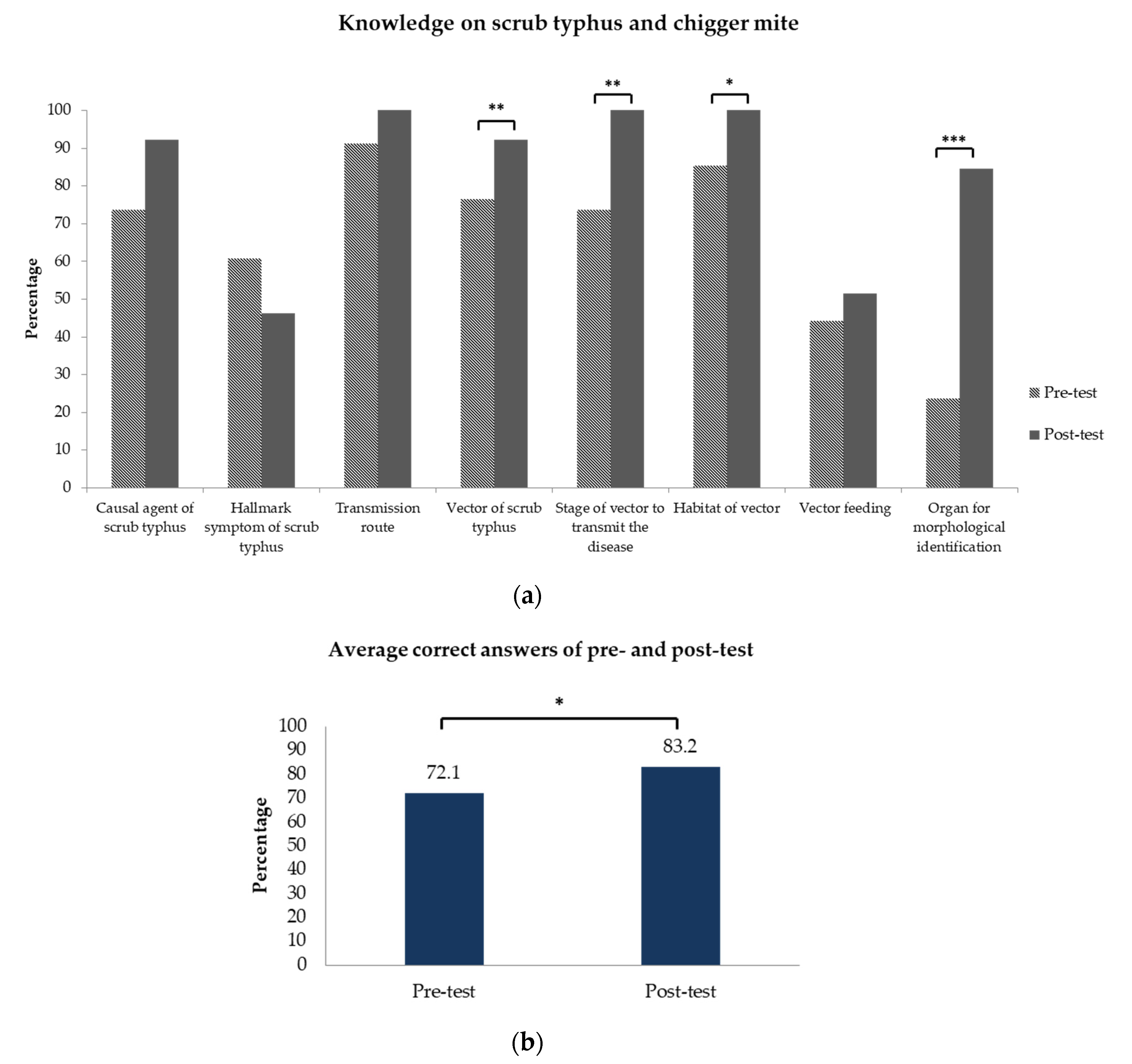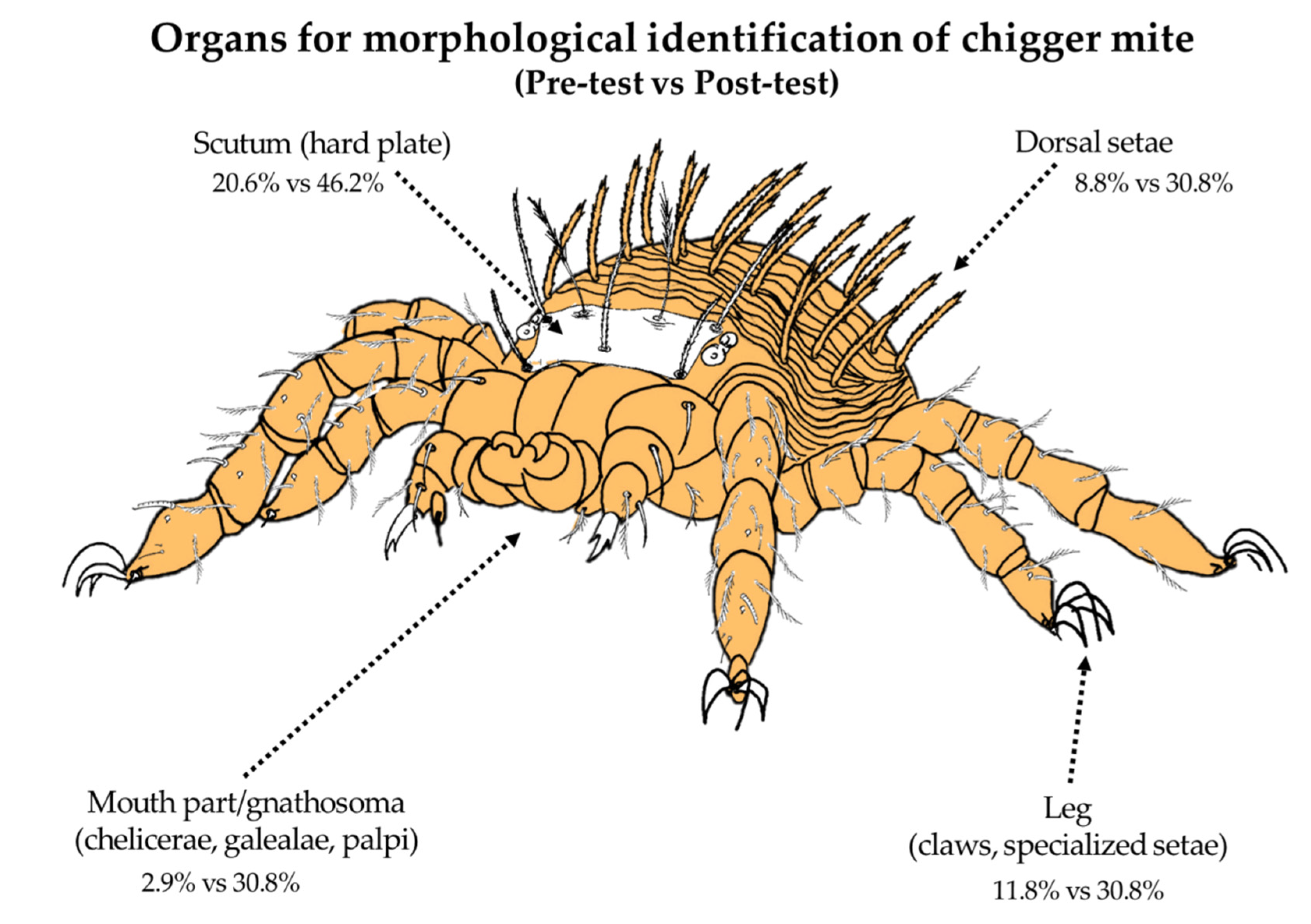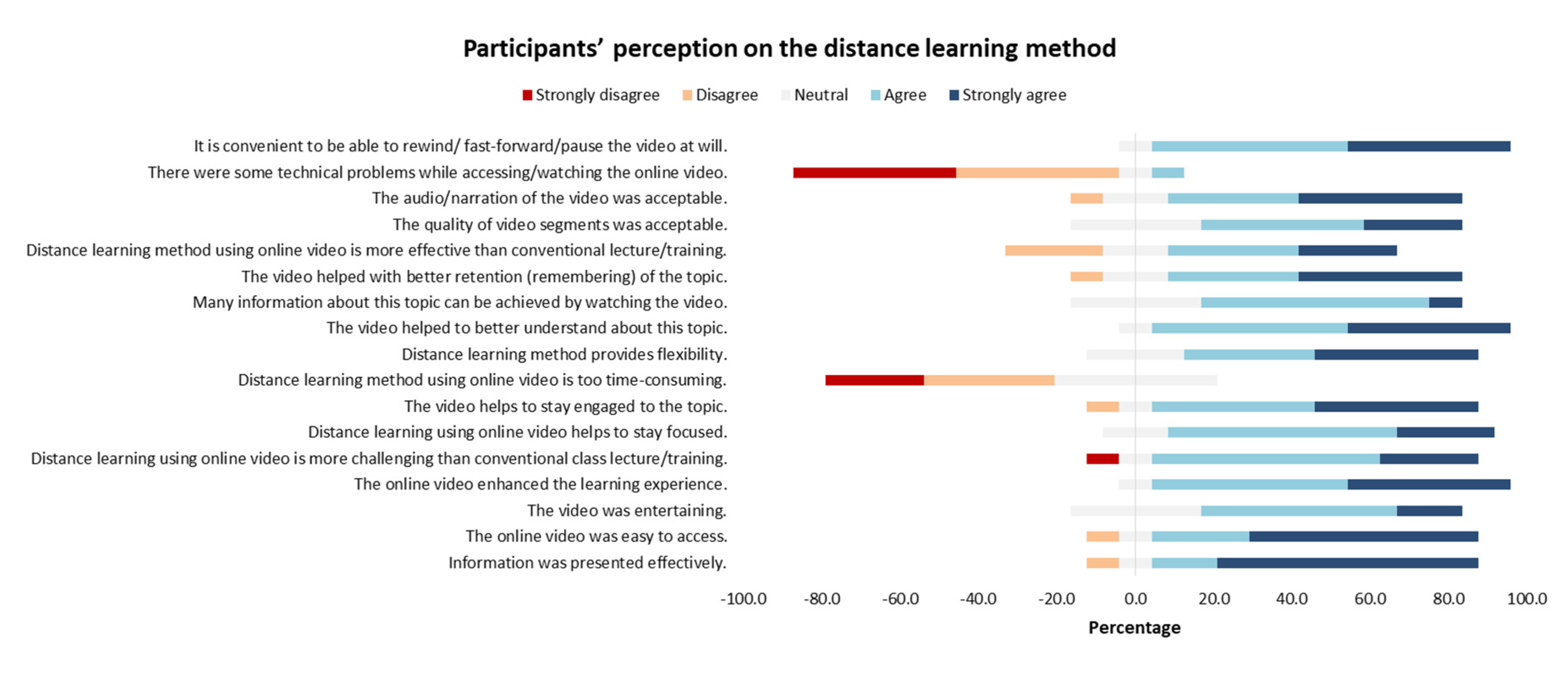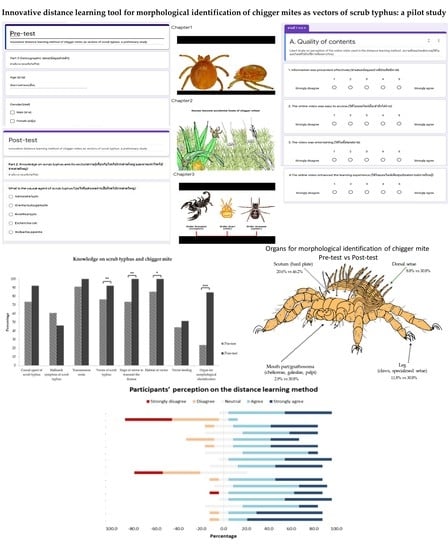Innovative Distance Learning Tool for Morphological Identification of Chigger Mites (Actinotrichida) as Vectors of Scrub Typhus: A Pilot Study
Abstract
1. Introduction
2. Materials and Methods
2.1. Study Participants
2.2. Video Module
2.3. Evaluation and Assessment of Participants’ Engagement
2.4. Statistical Analysis
3. Results
3.1. Demographic Data
3.2. Knowledge Improvement after the Distance Learning Method
3.3. Morphological Identification of Chigger Mite
3.4. Participants’ Feedback towards the Distance Learning Method
4. Discussion
5. Conclusions
Supplementary Materials
Author Contributions
Funding
Acknowledgments
Conflicts of Interest
References
- Yamamoto, S.; Kawabata, N.; Tamura, A.; Urakami, H.; Ohashi, N.; Murata, M.; Yoshida, Y.; Kawamura, A., Jr. Immunological Properties of Rickettsia tsutsugamushi Kawasaki Strain, Isolated from a Patient in Kyushu. Microbiol. Immunol. 1986, 30, 611–620. [Google Scholar] [CrossRef] [PubMed]
- Bureau of Epidemiology (MOPH) Thailand. Scrub Typhus; Bureau of Epidemiology (MOPH) Thailand: Bangkok, Thailand, 1980. Available online: http://www.boe.moph.go.th/boedb/surdata/disease.php?ds=44 (accessed on 19 January 2020).
- Suttinont, C.; Losuwanaluk, K.; Niwatayakul, K.; Hoontrakul, S.; Intaranongpai, W.; Silpasakorn, S.; Suwancharoen, D.; Panlar, P.; Saisongkorh, W.; Rolain, J.M.; et al. Causes of acute, undifferentiated, febrile illness in rural Thailand: Results of a prospective observational study. Ann. Trop. Med. Parasitol. 2006, 100, 363–370. [Google Scholar] [CrossRef] [PubMed]
- Phongmany, S.; Rolain, J.M.; Phetsouvanh, R.; Blacksell, S.D.; Soukkhaseum, V.; Rasachack, B.; Phiasakha, K.; Soukkhaseum, S.; Frichithavong, K.; Chu, V.; et al. Rickettsial infections and fever, Vientiane, Laos. Emerg. Infect. Dis. 2006, 12, 256–262. [Google Scholar] [CrossRef] [PubMed]
- Pham, T.T.T.; See, H.H.; Morand, R.; Krähenbühl, S.; Hauser, P.C. Determination of free and total valproic acid in human plasma by capillary electrophoresis with contactless conductivity detection. J. Chromatogr. B Analyt. Technol. Biomed. Life Sci. 2012, 907, 74–78. [Google Scholar] [CrossRef]
- Potts, J. Eradication of ectoparasites in children: How to treat infestations of lice, scabies, and chiggers. Postgrad. Med. 2001, 110, 57–64. [Google Scholar] [CrossRef]
- Roberts, L.W.; Rapmund, G.; Cadigan, F.C., Jr. Sex ratios in rickettsia tsutsugamushi-infected and noninfected colonies of Leptotrombidium (Acari: Trombiculidae). J. Med. Entomol. 1977, 14, 89–92. [Google Scholar] [CrossRef]
- Roberts, L.W.; Robinson, D.M. Efficiency of transovarial transmission of Rickettsia tsutsugamushi in Leptotrombidium arenicola (Acari: Trombiculidae). J. Med. Entomol. 1977, 13, 493–496. [Google Scholar] [CrossRef]
- Pham, X.D.; Otsuka, Y.; Suzuki, H.; Takaoka, H. Detection of Orientia tsutsugamushi (Rickettsiales: Rickettsiaceae) in unengorged chiggers (Acari: Trombiculidae) from Oita Prefecture, Japan, by nested polymerase chain reaction. J. Med. Entomol. 2001, 38, 308–311. [Google Scholar] [CrossRef]
- Chaisiri, K.; Cosson, J.-F.; Morand, S. Infection of rodents by Orientia tsutsugamushi, the agent of scrub typhus in relation to land use in Thailand. Trop. Med. Infect. Dis. 2017, 2, 53. [Google Scholar] [CrossRef]
- Lerdthusnee, K.; Nigro, J.; Monkanna, T.; Leepitakrat, W.; Leepitakrat, S.; Insuan, S.; Charoensongsermkit, W.; Khlaimanee, N.; Akkagraisee, W.; Chayapum, K.; et al. Surveys of rodent-borne disease in Thailand with a focus on scrub typhus assessment. Integr. Zool. 2008, 3, 267–273. [Google Scholar] [CrossRef]
- Leesa-Nguansuk, S. Thailand Tops Global Digitl Rankings. 2019. Available online: https://www.bangkokpost.com/business/1631402/thailand-tops-global-digital-rankings (accessed on 19 February 2020).
- Chen, J. Social Media Demographics to Inform Your Brand’s Strategy in 2020. 2020. Available online: https://sproutsocial.com/insights/new-social-media-demographics/ (accessed on 19 February 2020).
- Bluehost. Themainstreet Analyst. 2012. Available online: http://www.themainstreetanalyst.com/2012/08/22/the-growth-of-the-internet-over-the-past-10-years-infographic/ (accessed on 18 January 2020).
- Parusheva, S.; Aleksandrova, Y.; Hadzhikolev, A. Use of Social Media in Higher Education Institutions—An Empirical Study Based on Bulgarian Learning Experience. Tem J. 2018, 7, 171. [Google Scholar]
- Candarli, D.; Yuksel, H.G. Students’ perceptions of video-conferencing in the classrooms in higher education. Procedia Soc. Behav. Sci. 2012, 47, 357–361. [Google Scholar] [CrossRef]
- Robertson, J.S.; Grant, M.M.; Jackson, L. Is online instruction perceived as effective as campus instruction by graduate students in education? Int. High. Educ. 2005, 8, 73–86. [Google Scholar] [CrossRef]
- Maki, R.H.; Maki, W.S. Online Courses. In Handbook of Applied Cognition; Durso, F.T., Nickerson, R.S., Dumais, S.T., Lewandowsky, S., Perfect, T.J., Eds.; John Wiley & Sons, Ltd.: West Sussex, UK, 2007; pp. 527–552. [Google Scholar]
- Bayram, L. Enhancing an online distance education course with video. Procedia-Soc. Behav. Sci. 2013, 83, 5. [Google Scholar] [CrossRef][Green Version]
- Maki, R.H.; Maki, W.S. Online courses. Handb. Appl. Cogn. 2007, 2, 527–552. [Google Scholar]
- Buakanok, F.S. Educational Media Development Using Community Participatory Development Approach for Establishing Awareness of community Health: A Case Study Bann Pae Don Ton, Chompoo Sub-District, Lampang Province. J. Educ. Stud. 2015, 43, 63–79. [Google Scholar]
- Chung, L.-H.; Wu, W.-J.; Wang, H.-C. Chigger Mite Fauna of Taiwan (Acari: Trombiculidae and Leeuwenhokiidae); Ministry of Health and Welfare and National Taiwan University: Taipei, Taiwan, 2015.
- Goff, M.L.; Loomis, R.B.; Welbourn, W.C.; Wrenn, W.J. A glossary of chigger terminology (Acari: Trombiculidae). J. Med. Entomol. 1982, 19, 221–238. [Google Scholar] [CrossRef]
- Stekolnikov, A.A. Leptotrombidium (Acari: Trombiculidae) of the World. Zootaxa 2013, 3728, 1–173. [Google Scholar] [CrossRef]
- Stefanidis, D.; Korndorffer, J.R., Jr.; Heniford, B.T.; Scott, D.J. Limited feedback and video tutorials optimize learning and resource utilization during laparoscopic simulator training. Surgery 2007, 142, 202–206. [Google Scholar] [CrossRef]
- Manowong, S. Undergraduate students’ perceptions of Edmodo as a supplementary learning tool in an EFL classroom. Humanit. Arts Soc. Sci. Stud. (Former Name Silpakorn Univ. J. Soc. Sci. Humanit. Arts) 2016, 16, 137–162. [Google Scholar]
- He, Y.; Swenson, S.; Lents, N. Online video tutorials increase learning of difficult concepts in an undergraduate analytical chemistry course. J. Chem. Educ. 2012, 89, 1128–1132. [Google Scholar] [CrossRef]
- Saranya, S.M.; Vijayalakshmi, M. Interactive mobile live video learning system in cloud environment. In Proceedings of the 2011 International Conference on Recent Trends in Information Technology (ICRTIT), Chennai, India, 3–5 June 2011; IEEE: Piscataway, NJ, USA, 2011. [Google Scholar]
- Koumi, J. Designing Video and Multimedia for Open and Flexible Learning; Routledge: Abingdon, UK, 2006. [Google Scholar]
- Yousef, A.M.F.; Chatti, M.A.; Schroeder, U. The state of video-based learning: A review and future perspectives. Int. J. Adv. Life Sci. 2014, 6, 122–135. [Google Scholar]



| - | Variables | Number | (%) |
|---|---|---|---|
| Gender | Male | 19 | (55.9) |
| Female | 15 | (44.1) | |
| Age | 20 to 29 | 15 | (44.1) |
| 30 to 39 | 17 | (50.0) | |
| 40 to 49 | 2 | (5.9) | |
| Nationality | Thai | 30 | (88.2) |
| Non-Thai | 4 | (11.8) | |
| Education | High school | 2 | (5.9) |
| Bachelor degree | 11 | (32.4) | |
| Master degree | 11 | (32.4) | |
| Doctoral degree | 9 | (26.5) | |
| Others | 1 | (2.9) | |
| Occupation | Student | 6 | (17.6) |
| Laboratory technician | 6 | (17.6) | |
| Researcher | 6 | (17.6) | |
| Lecturer | 3 | (8.8) | |
| Public health officer | 7 | (20.6) | |
| Others | 6 | (17.6) | |
| Prior experience/training on scrub typhus | Yes | 14 | (41.2) |
| No | 19 | (55.9) | |
| Prior experience/training on ectoparasites | Yes | 16 | (47.1) |
| No | 18 | (52.9) |
| Variables | Pre-Test | (%) | Post-Test | (%) | Chi-Square | Z-Score |
| Causal agent of scrub typhus | 25 | (73.5) | 31 | (92.3) | 2.52 | 1.91 |
| Hallmark symptom of scrub typhus | 21 | (60.6) | 16 | (46.2) | 0.95 | 1.22 |
| Transmission route | 31 | (91.2) | 34 | (100) | NA | 1.77 |
| Vector of scrub typhus | 26 | (76.5) | 31 | (92.3) | 1.74 | ** 3.01 |
| Stage of vector to transmit the disease | 25 | (73.5) | 34 | (100) | NA | ** 3.22 |
| Habitat of vector | 29 | (85.3) | 34 | (100) | NA | * 2.32 |
| Vector feeding | 15 | (44.1) | 18 | (51.5) | 0.24 | 0.73 |
| Vector Morphological Identification | Pre-Test | (%) | Post-Test | (%) | Chi-Square | Z-Score |
| Organs for morphological identification | 8 | (23.5) | 29 | (84.6) | *** 23.71 | *** 5.11 |
| Scutum | 7 | (20.6) | 16 | (46.2) | - | - |
| Setae | 3 | (8.8) | 10 | (30.8) | - | - |
| Legs | 4 | (11.8) | 10 | (30.8) | - | - |
| Mouth part | 1 | (2.9) | 10 | (30.8) | - | - |
| Others | 0 | (0.0) | 5 | (15.4) | - | - |
© 2020 by the authors. Licensee MDPI, Basel, Switzerland. This article is an open access article distributed under the terms and conditions of the Creative Commons Attribution (CC BY) license (http://creativecommons.org/licenses/by/4.0/).
Share and Cite
Kumlert, R.; Pawestri, A.R.; Linsuwanon, P.; Morand, S. Innovative Distance Learning Tool for Morphological Identification of Chigger Mites (Actinotrichida) as Vectors of Scrub Typhus: A Pilot Study. Trop. Med. Infect. Dis. 2020, 5, 55. https://doi.org/10.3390/tropicalmed5020055
Kumlert R, Pawestri AR, Linsuwanon P, Morand S. Innovative Distance Learning Tool for Morphological Identification of Chigger Mites (Actinotrichida) as Vectors of Scrub Typhus: A Pilot Study. Tropical Medicine and Infectious Disease. 2020; 5(2):55. https://doi.org/10.3390/tropicalmed5020055
Chicago/Turabian StyleKumlert, Rawadee, Aulia Rahmi Pawestri, Piyada Linsuwanon, and Serge Morand. 2020. "Innovative Distance Learning Tool for Morphological Identification of Chigger Mites (Actinotrichida) as Vectors of Scrub Typhus: A Pilot Study" Tropical Medicine and Infectious Disease 5, no. 2: 55. https://doi.org/10.3390/tropicalmed5020055
APA StyleKumlert, R., Pawestri, A. R., Linsuwanon, P., & Morand, S. (2020). Innovative Distance Learning Tool for Morphological Identification of Chigger Mites (Actinotrichida) as Vectors of Scrub Typhus: A Pilot Study. Tropical Medicine and Infectious Disease, 5(2), 55. https://doi.org/10.3390/tropicalmed5020055







